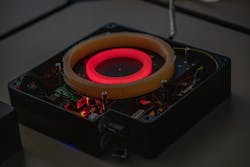iXblue fiber-optic dosimeter to be tested on board the International Space Station
iXblue (Lannion, France) and collaborators have developed a fiber-optic dosimeter that will be tested for the first time on board the International Space Station (ISS). This device has been designed to measure the radiation dose exposure in the station, with the goal of ensuring astronauts and equipment’s protection against ionizing radiation in space.
The collaborative LUMINA project was developed under the National Centre for Space Studies (CNES; Paris, France) leadership as part of the Alpha mission, conducted by the European Space Agency (ESA). The dosimeter, incorporating two fiber-optic coils several kilometers long, will be put in operation by French astronaut Thomas Pesquet on board the ISS.
iXblue fibers have been used for a long time in its fiber-optic gyroscopes in satellites, and the company noticed that these fibers darken under the effect of radiation, giving them the idea to harness the properties of these radiosensitive fibers to measure the level of ionizing radiation inside the ISS, explains Thierry Robin, R&D Director of iXblue's fiber division.
This technological demonstrator, based on radiosensitive fibers specifically designed for the mission and manufactured at iXblue’s facility in Lannion, was integrated by the company’s space teams in Saint-Germain-en Laye. It should enable data collection for several years, which will be regularly sent back to Earth for analysis. Indeed, the fiber darkening decreases the output light signal and it is therefore possible to correlate the optical loss with the radiation dose received, even at very low levels. This dosimeter could therefore be very useful for measuring the exposure of astronauts on the ISS, but also for future long-distance space missions to Mars to alert astronauts in the event of a solar storm and thus to protect them.
